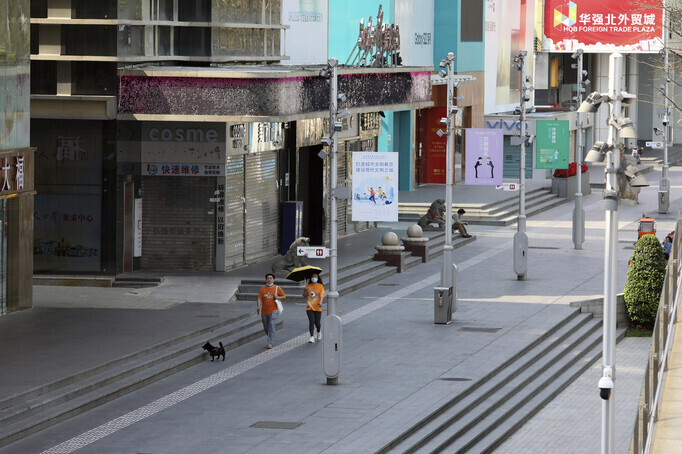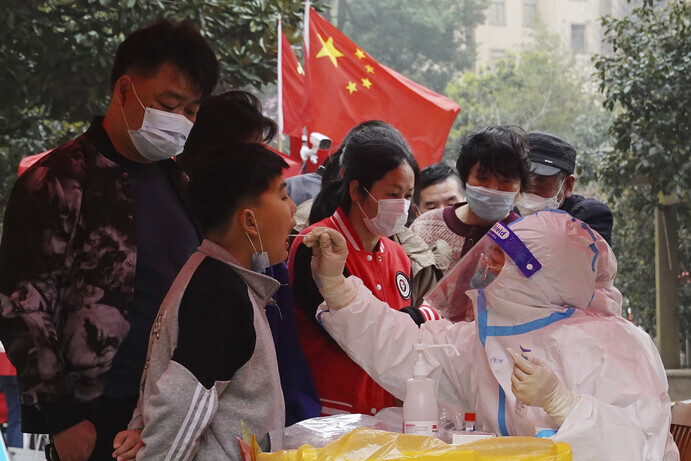hankyoreh
Links to other country sites 다른 나라 사이트 링크
Why China is doubling down on “zero-COVID” despite harsh lockdowns over Omicron

Amid its rigid adherence to a “zero-COVID” policy, China has imposed another round of intense lockdowns of unimaginable scale.
Shenzhen, a city of 17.5 million people in Guangdong Province that is ranked among China’s four biggest cities, was brought to a weeklong halt on Monday. In Jilin Province, the city of Changchun — with a population of 8 million — entered lockdown last week. In the economic capital of Shanghai, school attendance has been suspended for elementary, middle, and high school students.
With the spread of the highly transmissible Omicron variant of the virus, the “zero-COVID” policy has become effectively unsustainable — but China continues rigidly adhering to it.
According to figures from China’s National Health Commission (NHC), the number of new daily confirmed cases in China was up to 5,154 on Monday, compared with just 175 as recently as March 4.
Most of the new patients were infected with the highly transmissible Omicron variant.
As Omicron emerged as the predominant variant late last year, not only the US and the countries of Europe but also South Korea — which had been cited as a model example of disease control policies — responded to the new reality by adopting a policy approach of “living with” the virus. But China continues taking the opposite path.

Why does it refuse to give up on its zero-COVID policy?
The first reason has to do with the less effective domestically made vaccines that it has administered. Last year, China developed its own vaccines — produced by the companies Sinovac and Sinopharm — without acquiring the overseas vaccines produced by Pfizer and BioNTech, Moderna, and others.
The Chinese vaccines were created under the traditional approach, where a virus is deactivated and introduced into the body to trigger antibody production. These vaccines are cheap and easily stored and shipped — but they’re also less effective than the Pfizer and Moderna vaccines, which use messenger RNA (mRNA) technology.
World Health Organization figures showed the Pfizer vaccine as preventing 95% of COVID-19 infections, compared with a rate of just 51% for the Sinopharm vaccine.
The Chinese vaccines are also weak against Omicron.
According to research findings from the University of Hong Kong late last year, 5 out of 25 participants who had received the Pfizer vaccine were able to ward off infection with Omicron. Not one of the 25 participants who had received the Sinovac vaccine was able to do the same. If China were to give up on its zero-COVID policy, the rising caseload would soon be more than it could cope with.
Even bigger issues are the relatively poor healthcare infrastructure and regional imbalances. China is extremely short on intensive care unit beds where patients with severe symptoms can be treated.
The Chinese healthcare website Chinese Health Resources estimated the number of ICU beds in China at 4.37 per 100,000 people as of 2021 — compared with 29 for Germany, 35 for the US, and 12 for Italy.
Regional disparities are also severe. China’s two largest cities, Beijing and Shanghai, had rates of 6.25 and 6.14 ICU beds per 100,000 people, which was 1.5 times the national average. But in Jilin Province and the autonomous regions of Guangxi and Xizang (Tibet), the rate was under 3 per 100,000. The provinces of Gansu, Jiangxi, Hebei, Fujian, Anhui, and Hainan had rates below 3.5 per 100,000.
This means that a rise in severe cases could lead to a worst-case scenario with an explosive increase in deaths.

The biggest factor, however, is the political situation as President Xi Jinping prepares for a third term.
The decision on his third term is set to be made at the 20th Communist Party National Congress this fall. It’s the exclusive focus of all foreign and domestic policies at present, as China proceeds with an emphasis on stability.
Since Xi’s reappointment would be a break with the precedent for the Communist Party’s top leaders — who have traditionally served no mere than two five-year terms in a row, or 10 years altogether — China finds itself obliged to minimize any variables that might pop up along the way.
Additionally, China has touted its COVID-19 confirmed case numbers — which rank among the world’s lowest — as evidence of its system’s superiority to those of the US or Europe.
Lei Zhenglong, deputy head of the NHC Bureau of Disease Prevention and Control, said on Monday that the “zero-COVID” policy is “still effective” as a strategy for controlling the Omicron variant.
Signaling that China does not plan to backpedal on its approach, he stressed that “Omicron's stealth and rapid transmission means that faster and stricter measures should be taken.”
But Yanzhong Huang, a senior fellow for global health at the US Council on Foreign Relations, said that China’s zero-COVID policy was based on “buying time to administer vaccines.”
“With China’s vaccines proving so ineffective, it’s become difficult for them to cope with even small infection numbers,” he explained.
By Choi Hyun-june, staff reporter
Please direct questions or comments to [english@hani.co.kr]

Editorial・opinion
![[Column] Season 2 of special prosecutor probe may be coming to Korea soon [Column] Season 2 of special prosecutor probe may be coming to Korea soon](https://flexible.img.hani.co.kr/flexible/normal/500/300/imgdb/original/2024/0426/3317141030699447.jpg) [Column] Season 2 of special prosecutor probe may be coming to Korea soon
[Column] Season 2 of special prosecutor probe may be coming to Korea soon![[Column] Park Geun-hye déjà vu in Yoon Suk-yeol [Column] Park Geun-hye déjà vu in Yoon Suk-yeol](https://flexible.img.hani.co.kr/flexible/normal/500/300/imgdb/original/2024/0424/651713945113788.jpg) [Column] Park Geun-hye déjà vu in Yoon Suk-yeol
[Column] Park Geun-hye déjà vu in Yoon Suk-yeol- [Editorial] New weight of N. Korea’s nuclear threats makes dialogue all the more urgent
- [Guest essay] The real reason Korea’s new right wants to dub Rhee a founding father
- [Column] ‘Choson’: Is it time we start referring to N. Korea in its own terms?
- [Editorial] Japan’s rewriting of history with Korea has gone too far
- [Column] The president’s questionable capacity for dialogue
- [Column] Are chaebol firms just pizza pies for families to divvy up as they please?
- [Column] Has Korea, too, crossed the Rubicon on China?
- [Correspondent’s column] In Japan’s alliance with US, echoes of its past alliances with UK
Most viewed articles
- 1‘We must say no’: Seoul defense chief on Korean, USFK involvement in hypothetical Taiwan crisis
- 2N. Korean delegation’s trip to Iran shows how Pyongyang is leveraging ties with Moscow
- 3[Column] Season 2 of special prosecutor probe may be coming to Korea soon
- 4‘Weddingflation’ breaks the bank for Korean couples-to-be
- 5[Column] Has Korea, too, crossed the Rubicon on China?
- 6[Editorial] New weight of N. Korea’s nuclear threats makes dialogue all the more urgent
- 7[Reportage] On US campuses, student risk arrest as they call for divestment from Israel
- 8Korea sees more deaths than births for 52nd consecutive month in February
- 9[Column] Park Geun-hye déjà vu in Yoon Suk-yeol
- 10[Guest essay] The real reason Korea’s new right wants to dub Rhee a founding father